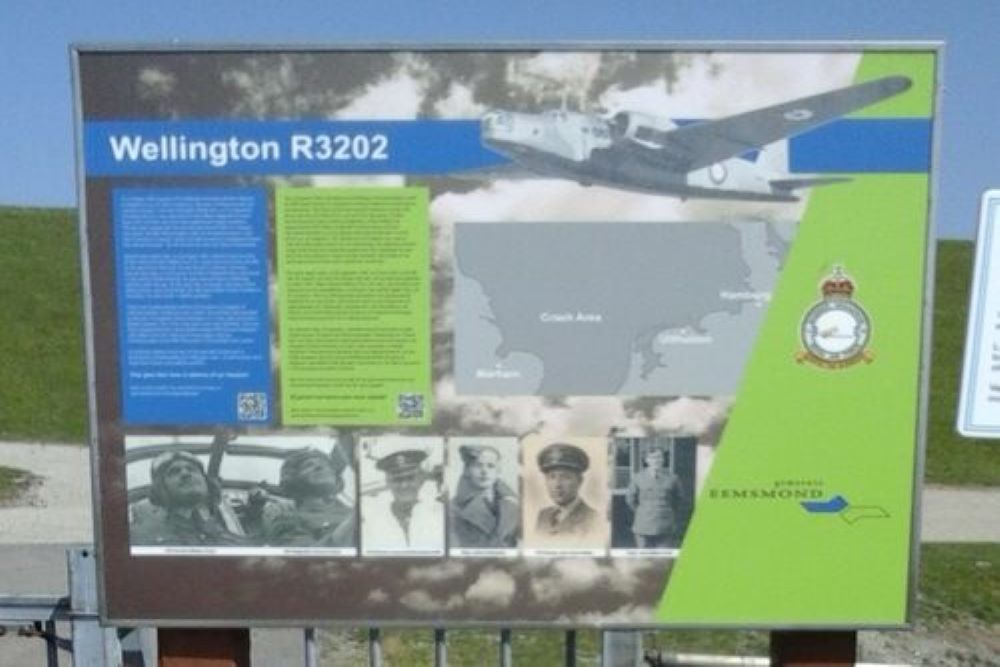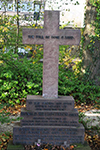Monument Wellington R 3202
On 2-8-1940, around half past nine in the evening, 22 Wellington bombers of the 115th squadron took off from the RAF base in Marham (U.K.). Their goal was to bomb an oil refinery near Hamburg (D). After the bombing had been successful, almost all bombers landed safely on their home base on 8/3/1940. One was missing. Only an emergency signal remained, which was received at home base between 01:45 and 02:15. From Rottumeroog it was reported that there were engine problems, to which it was soon added that keeping altitude was problematic. Eventually, Wellington Mk1c R3202 KO-J's signal would strike midway between the Dutch and British coasts.
A search in the North Sea in wartime means a search with limited resources and a limited time frame. Both the British and German navies have searched, but it should not be surprising that neither has yielded a conclusive answer. In the absence of evidence, the bomber was believed to have been shot down due to damage inflicted by a hostile aircraft. However, there would be no certainty. However, the remains of four crew members were recovered weeks later at various locations along the Dutch coast. West of the monument at Uithuizen, the body of Pilot Officer Ronald William Pryor (the co-pilot) was found in the salt marsh, close to the dike. A few days later, the body of Pilot Officer Reginald Torrance Gerry (the chief pilot) was found to have washed up on the beach of Rottum. On the same day, the bodies of Pilot Officer Sidney John Scott Wilde (a gunner) were spotted floating in the sea from the dyke above Delfzijl, while that of Sergeant James Dempsey (the radio operator) was found at the foot of the dyke at Heveskes. The bodies of Flight Sergeant Richard James Ruffell-Hazell (the observer) and Sergeant Jack Millen Croft (a gunner) have never been identified.
The state of the washed-up bodies or the autopsy after it showed that there could not have been a crash. So they must have made an emergency landing at sea. A successful emergency landing as these four crew members managed to survive in their inflatable life raft for several days before finally ending up in the sea and drowning. Which only adds to the mystery of Wellington Mk1c R3202 KO-J.
There are technical specifications of the plane, war reports, transcripts of the radio messages, autopsy reports and two court reports (about the farmer who 'coincidentally' found a watch half a meter from Ronald William Pryor and about the brushmaker who removed the ring from his finger). stole). Despite this, today people are still not sure what happened. Although the official reason is (still) downed due to damage inflicted by a hostile aircraft, the possibility of engine failure due to icing on the wings and in the engine is now also being considered. However, as the wreck of R3202 KO-J has never been identified and investigated, it will most likely remain so. Especially since the tides and currents in the North Sea ensure that the chance of discovery or research and therefore a definitive answer only decreases over time.
Do you have more information about this location? Inform us!
Source
- Text: Bert Deelman
- Photos: Bert Deelman
- Het mysterie van de R 3202
- Oorlogsgraf Britse RAF piloot Ronald William Pryor
Nearby
Monument
- War Memorial Uithuizermeeden - Uithuizermeeden
- War Memorial Uithuizen - Uithuizen
- Memorial Explosion General Cemetery Spijk - Spijk
Cemetery
- Dutch War Graves Municipal Cemetery Oosteinde - Oosteinde
- Dutch War Graves General Cemetery Uithuizermeeden - Uithuizermeeden
- Commonwealth War Graves General Cemetery Uithuizermeeden - Uithuizermeeden





